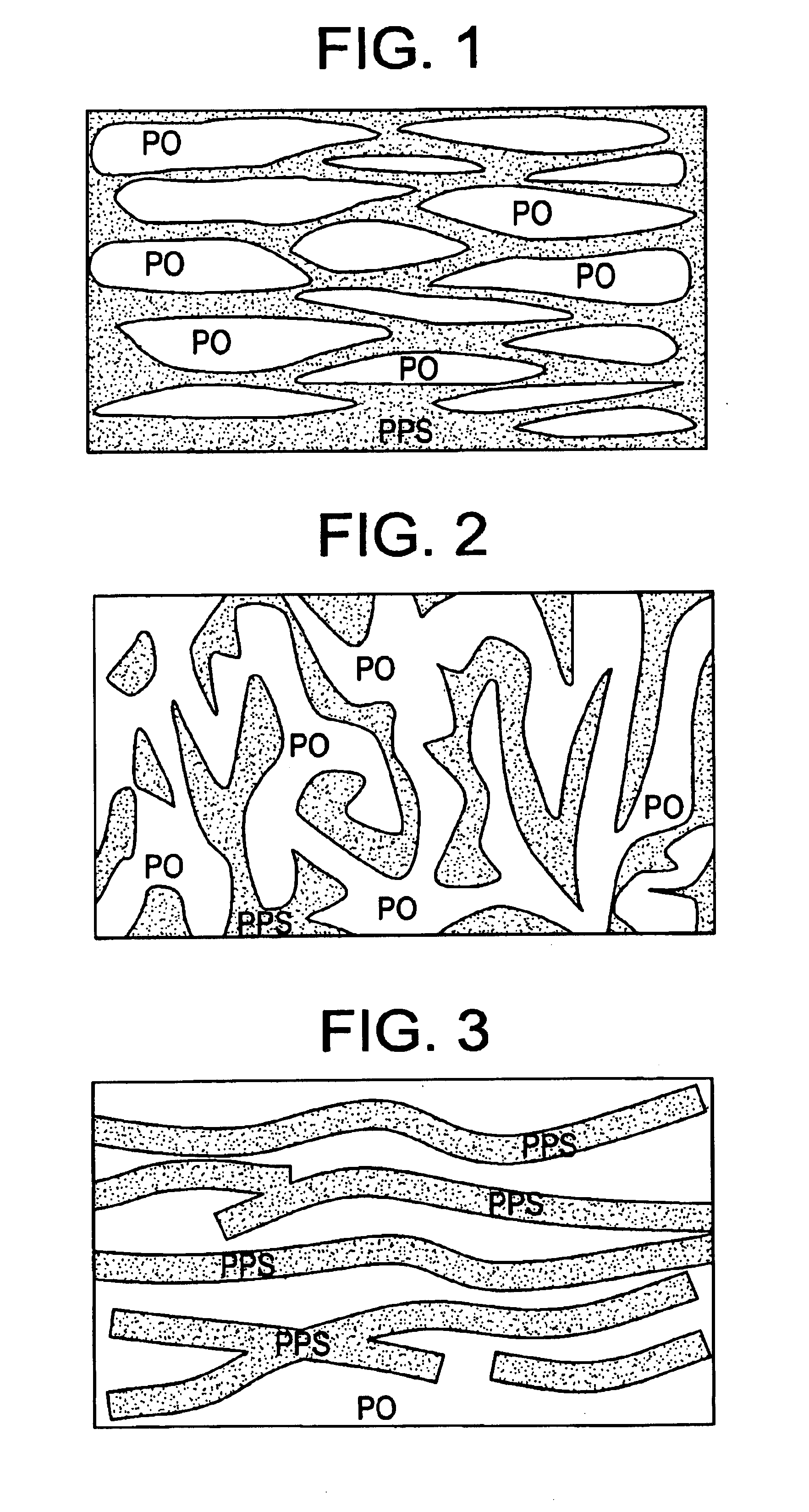Resin structure
a technology of resin structure and resin cylinder, which is applied in the field of resin structure, can solve the problems of unsatisfactory barrier properties of gasoline and other specific oils, difficult to directly use them for fuel tanks and oil tanks for automobiles, and difficult to achieve the effect of enhancing the productivity and industrial application of invention, good gas barrier properties, and convenient us
- Summary
- Abstract
- Description
- Claims
- Application Information
AI Technical Summary
Benefits of technology
Problems solved by technology
Method used
Image
Examples
reference example 1
Preparation of PPS Copolymer
[0108]3.26 kg of sodium sulfide (25 mols, containing 40% crystal water), 4 g of sodium hydroxide, 1.36 kg of sodium acetate trihydrate (about 10 mols), and 7.9 kg of N-methylpyrrolidone were fed into an autoclave equipped with a stirrer, and gradually heated up to 205° C. with stirring, and about 1.5 liters of distillate containing 1.36 kg of water was removed. To the residual mixture, added were 3.38 kg of 1,4-dichlorobenzene (23.0 mols), 0.37 kg of 1,3-dichlorobenzene (2.5 mols), and 2 kg of NMP, and heated at 265° C. for 5 hours. The reaction product was washed three times with hot water at 70° C., then with aqueous acetic acid solution with pH=4 at 60° C., and further four times with hot water at 70° C., and then dried under reduced pressure at 80° C. for 24 hours to obtain about 2 kg of a PPS copolymer resin having a melting point of 255° C. and MFR of 800 g / 10 min (at 315° C. under 5000 g).
[0109]The polyolefin resins and PPS used in Examples and Com...
examples 1 to 15
, COMPARATIVE EXAMPLES 1 TO 4
[0111]As in Tables 1 and 2, the mixture previously prepared by melting and kneading the PPS resin and a compatibilizer (ethylene / glycidyl methacrylate copolymer, 90 / 10% by weight), and the polyolefin resin were fed into a double-screw extruder, Nippon Seikosho's TEX 30 Model through its main feeder. The inorganic filler, if used, was fed thereinto through a side feeder provided at some part of the cylinder. These were kneaded in melt in the extruder at 300° C., for which the screw revolution was 200 rpm. The resulting pellets were dried, and then injection-molded into test pieces. The injection-molding machine used was Toshiba Kikai's IS100FA, and the mold temperature was 80° C. In addition, the pellets prepared in the same manner as above were molded into tubes for the test for alcohol gasoline transmission through them. The data of the transmission resistance and the mechanical strength of the samples are given in Tables 1 and 2. Some samples were anal...
examples 16 to 32
, COMPARATIVE EXAMPLES 5 TO 8
[0116]As in Tables 3 to 5, the PPS resin was mixed with a compatibilizer (ethylene / glycidyl methacrylate copolymer, 90 / 10% by weight), the resulting mixture was fed into a double-screw extruder, Nippon Seikosho's TEX 30 Model through its main feeder with the polyolefin resin being thereinto through a side feeder provided at some part of the cylinder, and these were kneaded in melt at 270 to 300° C., for which the screw revolution was 200 rpm. The resulting pellets were dried, and then molded into tubes.
[0117]In that manner, molded were three-resin three-layer tubes composed of one barrier layer (α), one neighboring layer (β) of thermoplastic resin, and one adhesive layer (γ) between the barrier layer and the neighboring layer (or two-resin two-layer tubes not having the adhesive layer). For these, the molding machine used has three extruders, a forming die, a sizing die and a take-up unit, in which the resin melts extruded out of the three extruders are ...
PUM
| Property | Measurement | Unit |
|---|---|---|
| density | aaaaa | aaaaa |
| melt flow rate | aaaaa | aaaaa |
| degree of crystallinity | aaaaa | aaaaa |
Abstract
Description
Claims
Application Information
 Login to View More
Login to View More - R&D
- Intellectual Property
- Life Sciences
- Materials
- Tech Scout
- Unparalleled Data Quality
- Higher Quality Content
- 60% Fewer Hallucinations
Browse by: Latest US Patents, China's latest patents, Technical Efficacy Thesaurus, Application Domain, Technology Topic, Popular Technical Reports.
© 2025 PatSnap. All rights reserved.Legal|Privacy policy|Modern Slavery Act Transparency Statement|Sitemap|About US| Contact US: help@patsnap.com



